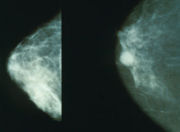 A computer can safely replace a medical expert in a revolutionary way of interpreting a breast X-ray – according to a Cancer Research UK funded study.
A computer can safely replace a medical expert in a revolutionary way of interpreting a breast X-ray – according to a Cancer Research UK funded study.
A new study, published last week in the New England Journal of Medicine, has shown that a single trained expert plus a computer is just as effective at detecting breast cancer as the two experts who traditionally read a mammogram in the UK. In the United States and some other European countries only a single expert reads mammograms. This means that single readers using the computer aided detection program (CAD) will be even more effective at detecting breast cancer.
“The study has huge international significance,” said Professor Fiona Gilbert of the University of Aberdeen and lead author of the study. “Using CAD is likely to improve breast cancer detection in those countries where only a single reader is used.
“In the UK, it will mean that the same number of experts can read more mammograms in a given period of time. We want to offer screening to a wider age group, those 47-50years old and 70-73 years old, an increase of around 30 per cent. The national programme screens over 1.7 million each year. This computer technology will help us achieve this.”
The study invited around 28,000 women to have their mammograms read both in the conventional way by two radiologists and also by a single radiologist using the computer.
The results will be presented on Monday (October 6th) at the National Cancer Research Institute’s annual conference in Birmingham.
Researchers found that film readers using the computer-aided detection (CAD) programme – where mammograms were read by a single expert plus the computer – was as good at finding cancers as the standard UK practice where two experts read each mammogram.
Professor Stephen Duffy, Cancer Research UK’s professor of cancer screening, said: “Earlier studies had conflicting results about the success of the computer-aided readings. But this large study of 28,000 women carried out within the national programme means we can now say for certain that this system is as good at detecting breast cancer as the one used as standard practice.
“It means that the workload of radiologists and trained technicians who traditionally read all breast X-rays could be reduced by bringing in computers to help them.
“In some areas women do not get their screening invitations as regularly as they should – every three years – because there are simply not enough experts to go round. The CAD system would free up radiologists to work on more mammograms as only one instead of two would be required to read each X-ray.”
Dr Lesley Walker, Cancer Research UK’s director of information, said: “This is good news for women – particularly for those who live in areas where invitations for screening have been late in arriving.
“We will always need the human eye of an expert to read mammograms. In the rare instance when the computer is at odds with the radiologist the human interpretation takes precedence.
“But now we know that a computer can help give more accurate readings there is bound to be an improvement in the national screening programme which already saves 1400 lives a year through early detection of breast cancer.”
(Source: Cancer Research UK)



















